Media and tray
This chapter provides information on how to load print media into your machine.
|
|
|
|
|
|
|
|
The use of inflammable media or foreign materials left in the printer may lead to overheating of the unit and, in rare cases may cause a fire. |
To change the size, you need to adjust the paper guides.
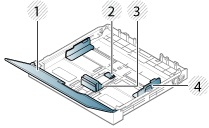
|
|
|
|
|
|
If you do not adjust the guide, it may cause paper registration, image skew, or jamming of the paper. |
|
|
|
|
Illustrations on this user’s guide may differ from your machine depending on its options or models. Check your machine type (see Front view). |
-
Pull out the paper tray (see Tray overview).
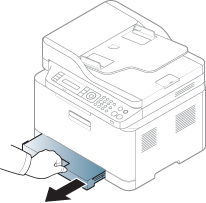
-
Open the paper cover.
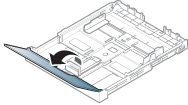
-
Press and unlatch the guide lock in the tray, pull the tray out manually. Then adjust the paper length guide and paper width guide.
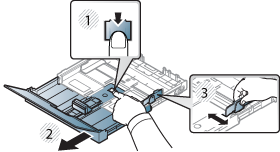
-
Flex or fan the edge of the paper stack to separate the pages before loading papers.

-
Place the paper with the side you want to print facing up.
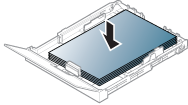
For paper smaller than A4-sized, press and unlatch the guide lock in the tray, push the tray in manually. Then adjust the paper length guide and paper width guide.
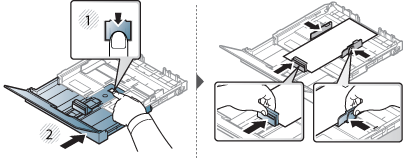
For paper longer than Legal-sized, press and unlatch the guide lock in the tray, pull the tray out manually. Then adjust the paper length guide and paper width guide.
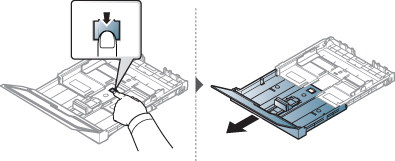
![[Note]](../../common/icon_note.png)
-
Do not push the paper width guide too far causing the media to buckle.
-
Do not use a paper with a leading-edge curl, it may cause a paper jam or the paper can be wrinkled.

-
If you do not adjust the paper width guide, it may cause paper jams.

-
-
Squeeze the paper width guide and slide it to the edge of the paper stack without causing it to buckle.
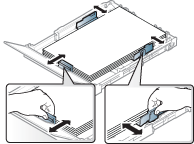
-
Close the paper cover.
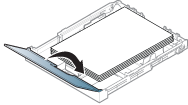
-
Insert the paper tray.
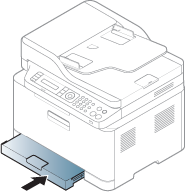
-
When you print a document, set the paper type and size for the tray (see Setting the paper size and type).
The tray is preset to Letter or A4 size, depending on your country. To change the size to A4 or Letter, you must adjust the lever and paper width guide properly.
-
Pull the tray out of the machine. Open the paper cover and remove paper from the tray if necessary.
-
If you want to change the size to Letter, hold the lever at the back of the tray, and rotate the lever clockwise.
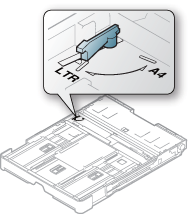
-
Squeeze the paper width guide and slide it to the edge of the lever.
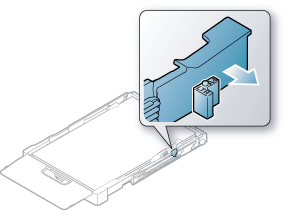
|
|
|
|
If you want to change the size to A4, first move the paper width guide to left and rotate the lever counterclockwise. If you force the lever, it could damage the tray. |
|
|
|
|
The table below shows the special media usable in tray.
The paper setting in the machine and driver should match to print without a paper mismatch error.
|
|
|
|
The paper setting in the machine and driver should match to print without a paper mismatch error.
|
To see paper weights for each sheet, refer to Print media specifications .
(●: Supported)
To avoid damaging the machine, use only labels designed for use in laser printers.
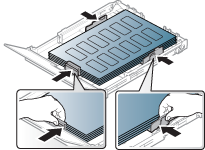
-
When selecting labels, consider the following factors:
-
Adhesives: Should be stable at your machine’s fusing temperature about 170°C (338°F).
-
Arrangement: Only use labels with no exposed backing between them. Labels can peel off sheets that have spaces between the labels, causing serious jams.
-
Curl: Must lie flat with no more than 13 mm of curl in any direction.
-
Condition: Do not use labels with wrinkles, bubbles, or other indications of separation.
-
-
Make sure that there is no exposed adhesive material between labels. Exposed areas can cause labels to peel off during printing, which can cause paper jams. Exposed adhesive can also cause damage to machine components.
-
Do not run a sheet of labels through the machine more than once. The adhesive backing is designed for only a single pass through the machine.
-
Do not use labels that are separating from the backing sheet or are wrinkled, bubbled, or otherwise damaged.
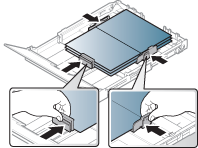
-
In the software application, set the margins to at least 6.4 mm (0.25 inches) away from the edges of the material.
When loading preprinted paper, the printed side should be facing up with an uncurled edge at the front. If you experience problems with paper feeding, turn the paper around. Note that print quality is not guaranteed.
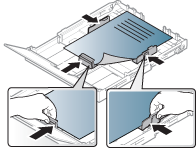
-
Must be printed with heat-resistant ink that will not melt, vaporize, or release hazardous emissions when subjected to the machine’s fusing temperature for 0.1 second (about 170°C (338°F)).
-
Preprinted paper ink must be non-flammable and should not adversely affect machine rollers.
-
Before you load preprinted paper, verify that the ink on the paper is dry. During the fusing process, wet ink can come off preprinted paper, reducing print quality.
After loading paper in the paper tray, set the paper size and type using the control panel buttons.
|
|
|
|
The paper setting in the machine and driver should match to print without a paper mismatch error.
|
-
Select
 () button on the
control panel.
() button on the
control panel. -
Press > > or .
-
Select the tray and the option you want.
-
Press to save the selection.
-
Press
 () to
return to ready mode.
() to
return to ready mode.
|
|
|
|
|
|
|
|
The surface of the output tray may become hot if you print a large number of pages at once. Make sure that you do not touch the surface, and do not allow children near it. |
The printed pages stack on the output support, and the output support will help the printed pages to align. The printer sends output to the output tray by default.

|
|
|
|
Illustrations on this user’s guide may differ from your machine depending on its options or models. Check your machine type (see Front view). |
-
Do not load paper smaller than 142 x 148 mm (5.6 x 5.8 inches) or larger than 216 x 356 mm (8.5 x 14 inches).
-
Do not attempt to load the following s of paper, in order to prevent paper jam, low print quality and machine damage.
-
Carbon-paper or carbon-backed paper
-
Coated paper
-
Onion skin or thin paper
-
Wrinkled or creased paper
-
Curled or rolled paper
-
Torn paper
-
-
Remove all staples and paper clips before loading.
-
Make sure any glue, ink, or correction fluid on the paper is completely dry before loading.
-
Do not load originals that include different sizes or weights of paper.
-
Do not load booklets, pamphlets, transparencies, or documents with other unusual characteristics.
You can use the scanner glass or the document feeder to load an original for copying, scanning, and sending a fax.
|
|
|
|
Illustrations on this user’s guide may differ from your machine depending on its options or models. Check your machine type (see Front view). |
On the scanner glass
Using the scanner glass, you can copy or scan originals. You can get the best scan quality, especially for colored or gray-scaled images. Make sure that no originals are in the document feeder. If an original is detected in the document feeder, the machine gives it priority over the original on the scanner glass.
-
Lift and open the scanner lid.
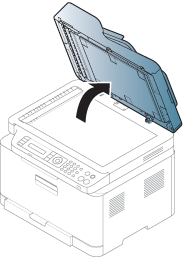
-
Place the original face down on the scanner glass. Align it with the registration guide at the top left corner of the glass.
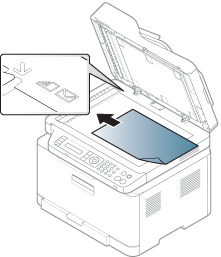
-
Close the scanner lid.
|
|
|
|
|
|
|
|
In the document feeder
-
Flex or fan the edge of the paper stack to separate the pages before loading originals.

-
Load the original face up into the document feeder input tray. Make sure that the bottom of the original stack matches the paper size marked on the document input tray.
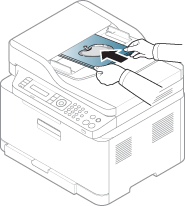
-
Adjust the document feeder width guides to the paper size.
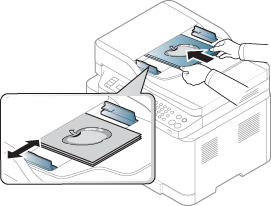
|
|
|
|
Dust on the document feeder glass may cause black lines on the printout. Always keep the glass clean (see Cleaning the machine). |